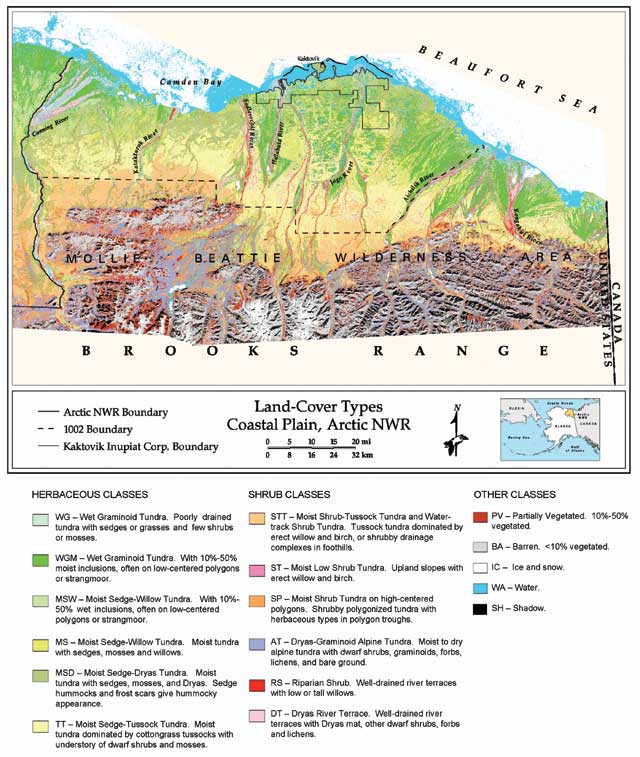
Arctic vegetation
Introduction
The type of vegetation in Arctic National Wildlife Refuge (ANWR) is mainly
characterized as “tundra”, meaning barren land. Contradictory
to its literal name, vegetation on the arctic tundra is highly diverse.
The types of vegetation found depends on numerous factors such as the
terrain, local climate, permafrost and active layer depths, precipitation
and water availability and drainage, nutrient availability and cycling.
The shrub tundras are dominated by deciduous vascular plants.
Slightly warmer soil temperatures, deeper thaw, and more rapid nitrogen
mineralization associated with the high water flow rate in water track
and river bar localities cause denser canopies and higher total foliar
nitrogen.
The differences in canopy structure between the graminoid-dominated wetland
tundras and the mixed tussock tundra communities are probably related
to drainage characteristics and their effects on nutrient availability.
The highly heterogeneous nature of the heath sites is probably determined
by their different degrees of exposure on ridge and hill tops. Microtopography
affects the growth and structure of heath, with sheltered hollows causing
denser vegetation and ridge tops causing sparse canopies. (Shaver et al.,
1996)
The arctic coastal tundra consists of thaw lakes and wetlands near the
Beaufort Sea coast and along river deltas. The foothills tundra, a transition
between this and the Brooks Range, is dominated by sedge tussock (Eriophorum
vaginatum), which provides the lush, new growth needed to feed caribou
calves and energize staging snow geese. Riparian areas have willow shrubs
that are important nesting habitat for migratory birds. (World Wide Fund
for Nature, 2000)
 Diverse vegetation
in Arctic National Wildlife Refuge
Diverse vegetation
in Arctic National Wildlife Refuge
Photo: Subhankar Banerjee
The tundra plants are usually less than 1 foot high. Tall
plants are restricted to the southern slopes of ANWR. The tundra plants
belong to five main groups:
1. Lichens, either on rocks or in mats on the ground
2. Bryophytes (commonly known as mosses)
3. Grasses and grass-like herbs, including mainly sedges
and willows
4. Cushion plants
5. Dwarf shrubs
(Patrick D. Baird, 1964; Janet C. Jorgenson, Peter C. Joria, and
David C. Douglas, 2002)
In ANWR, the following four types of plants are particularly important:
1. Sedges, especially tussock cottongrass
2. Willows, especially diamond-leaf willows
3. Mosses, especially Sphagnum spp.
4. Lichens, of various types
The first two is highly nutritious for herbivores to feed on as a food
source, particularly during the growing seasons, while the latter two
help maintain the ecosystems in other ways and provide food during winter.

Map showing vegetation pattern of ANWR
(Map: http://www.absc.usgs.gov/1002/section2.htm)Reference:
1. Williams, M.; Rastetter, E. (1999). Vegetation characteristics
and primary productivity along an arctic transect: implication for scaling-up.
Journal of Ecology 1999, 87: 885-898.
2. World Wide Fund for Nature. (2000). Protection of
the Artic National Wildlife Refuge: Key to Managing one of the World's
Most Biologically Valuable Ecoregions, the Arctic Coastal Tundra, http://www.worldwildlife.org/arctic-refuge/anwr_position.pdf
3. Janet C. Jorgenson, Peter C. Joria, and David C.
Douglas. (2002). Arctic Refuge Coastal Plain Terrestrial Wildlife Research
Summaries. http://www.absc.usgs.gov/1002/section2.htm
4. Patrick D. Baird. (1964). The Polar World.





